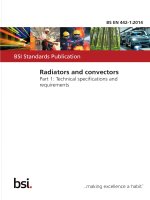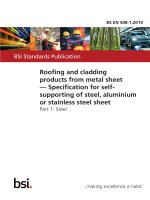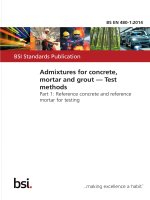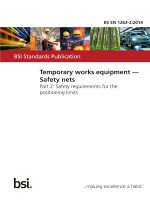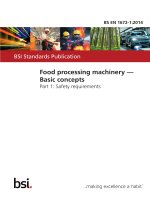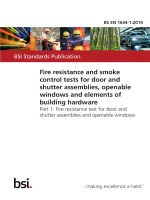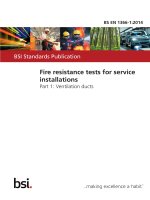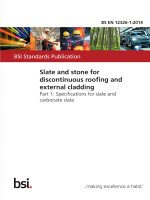Bsi bs en 01263 1 2014
Bạn đang xem bản rút gọn của tài liệu. Xem và tải ngay bản đầy đủ của tài liệu tại đây (1.53 MB, 46 trang )
BS EN 1263-1:2014
BSI Standards Publication
Temporary works equipment —
Safety nets
Part 1: Safety requirements, test methods
BS EN 1263-1:2014
BRITISH STANDARD
National foreword
This British Standard is the UK implementation of EN 1263-1:2014. It
supersedes BS EN 1263-1:2002 which is withdrawn.
The UK participation in its preparation was entrusted to Technical
Committee B/514/27, Nets and sheets.
A list of organizations represented on this committee can be
obtained on request to its secretary.
This publication does not purport to include all the necessary
provisions of a contract. Users are responsible for its correct
application.
© The British Standards Institution 2014. Published by BSI Standards
Limited 2014
ISBN 978 0 580 80841 8
ICS 13.340.60
Compliance with a British Standard cannot confer immunity from
legal obligations.
This British Standard was published under the authority of the
Standards Policy and Strategy Committee on 31 December 2014.
Amendments issued since publication
Date
Text affected
BS EN 1263-1:2014
EN 1263-1
EUROPEAN STANDARD
NORME EUROPÉENNE
EUROPÄISCHE NORM
December 2014
ICS 13.340.60
Supersedes EN 1263-1:2002
English Version
Temporary works equipment - Safety nets - Part 1: Safety
requirements, test methods
Équipements temporaires de chantiers - Filets de sécurité Partie 1 : Exigences de sécurité, méthodes d'essai
Temporäre Konstruktionen für Bauwerke - Schutznetze
(Sicherheitsnetze) - Teil 1: Sicherheitstechnische
Anforderungen, Prüfverfahren
This European Standard was approved by CEN on 8 November 2014.
CEN members are bound to comply with the CEN/CENELEC Internal Regulations which stipulate the conditions for giving this European
Standard the status of a national standard without any alteration. Up-to-date lists and bibliographical references concerning such national
standards may be obtained on application to the CEN-CENELEC Management Centre or to any CEN member.
This European Standard exists in three official versions (English, French, German). A version in any other language made by translation
under the responsibility of a CEN member into its own language and notified to the CEN-CENELEC Management Centre has the same
status as the official versions.
CEN members are the national standards bodies of Austria, Belgium, Bulgaria, Croatia, Cyprus, Czech Republic, Denmark, Estonia,
Finland, Former Yugoslav Republic of Macedonia, France, Germany, Greece, Hungary, Iceland, Ireland, Italy, Latvia, Lithuania,
Luxembourg, Malta, Netherlands, Norway, Poland, Portugal, Romania, Slovakia, Slovenia, Spain, Sweden, Switzerland, Turkey and United
Kingdom.
EUROPEAN COMMITTEE FOR STANDARDIZATION
COMITÉ EUROPÉEN DE NORMALISATION
EUROPÄISCHES KOMITEE FÜR NORMUNG
CEN-CENELEC Management Centre: Avenue Marnix 17, B-1000 Brussels
© 2014 CEN
All rights of exploitation in any form and by any means reserved
worldwide for CEN national Members.
Ref. No. EN 1263-1:2014 E
BS EN 1263-1:2014
EN 1263-1:2014 (E)
Contents
Page
Foreword ..............................................................................................................................................................4
Introduction .........................................................................................................................................................5
1
Scope ......................................................................................................................................................6
2
Normative references ............................................................................................................................6
3
3.1
3.2
Symbols and terms and definitions .....................................................................................................6
Symbols ..................................................................................................................................................6
Terms and definitions ...........................................................................................................................8
4
4.1
4.2
4.3
Classification..........................................................................................................................................9
Nets .........................................................................................................................................................9
Safety nets ..............................................................................................................................................9
Ropes ................................................................................................................................................... 12
5
5.1
5.2
Designation ......................................................................................................................................... 14
Safety net ............................................................................................................................................. 14
Rope ..................................................................................................................................................... 14
6
6.1
6.2
6.3
6.4
6.5
6.6
6.7
Requirements ...................................................................................................................................... 14
Construction ........................................................................................................................................ 14
Tensile strength of ropes ................................................................................................................... 16
Energy absorption capacity of the test mesh .................................................................................. 16
Static strength of a net sample ......................................................................................................... 16
Dynamic strength of safety net System S (net with border rope) ................................................. 17
Dynamic strength of safety net System T (net attached on brackets for horizontal use)........... 17
Dynamic strength of safety net System U (net attached to supporting construction for
vertical use) ......................................................................................................................................... 17
Dynamic strength of safety net System V (net with border rope attached to a gallow type
support) ............................................................................................................................................... 17
6.8
7
7.1
7.2
7.3
7.4
7.5
7.6
7.7
7.8
7.9
7.10
7.13
Test methods....................................................................................................................................... 17
General ................................................................................................................................................. 17
Dimensional inspection of the mesh size ........................................................................................ 18
Test method for mesh rope ............................................................................................................... 19
Test for the static strength of nets.................................................................................................... 21
Test for the breaking load of border-, tie- and coupling ropes ...................................................... 23
Test for the energy absorption capacity of the net mesh .............................................................. 23
Natural ageing test.............................................................................................................................. 23
Artificial ageing test ........................................................................................................................... 26
Testing the dynamic strength of safety nets System S (net with border ropes) ......................... 31
Testing the dynamic strength of safety nets System T (nets attached on brackets for
horizontal use...................................................................................................................................... 32
Testing the dynamic strength of safety nets System U (net attached to supporting
framework for vertical use ................................................................................................................. 35
Testing the dynamic strength of safety nets System V (net with border rope attached to a
gallow type support) ........................................................................................................................... 36
Test report ........................................................................................................................................... 37
8
Marking and labelling ......................................................................................................................... 38
9
Handling instructions ......................................................................................................................... 38
10
Conformity ........................................................................................................................................... 38
7.11
7.12
2
BS EN 1263-1:2014
EN 1263-1:2014 (E)
Annex A (informative) Prototype assessment ............................................................................................... 39
Annex B (informative) On-going production inspection ............................................................................... 40
B.1
On-going production inspection ........................................................................................................ 40
B.2
Annual inspection of test mesh ......................................................................................................... 41
Bibliography ...................................................................................................................................................... 42
3
BS EN 1263-1:2014
EN 1263-1:2014 (E)
Foreword
This document (EN 1263-1:2014) has been prepared by Technical Committee CEN/TC 53 “Temporary works
equipment”, the secretariat of which is held by DIN.
This European Standard shall be given the status of a national standard, either by publication of an identical
text or by endorsement, at the latest by June 2015 and conflicting national standards shall be withdrawn at the
latest by June 2015.
Attention is drawn to the possibility that some of the elements of this document may be the subject of patent
rights. CEN [and/or CENELEC] shall not be held responsible for identifying any or all such patent rights.
This document supersedes EN 1263-1:2002.
This European Standard is one of a series of standards as listed below:
—
EN 1263-1, Temporary works equipment — Safety nets — Part 1: Safety requirements, test methods
—
EN 1263-2, Temporary works equipment — Safety nets — Part 2: Safety requirements for the erection of
safety nets
The significant changes incorporated in this revision are:
a)
replacement of Figure 4;
b)
addition of a new rope denominated “W” in Table 2;
c)
deletion of designation for nets;
d)
change of designation for ropes;
e)
complete revision of Clause 7 (test methods), incorporation of the description of a new vertical test rig
and new figures for the mash samples;
f)
revision of dimensional inspection of the mesh size;
g)
replacement of Figure 9 and Figure 10 with new figures in 7.7.4.2 (interpretation of the results).
According to the CEN-CENELEC Internal Regulations, the national standards organizations of the following
countries are bound to implement this European Standard: Austria, Belgium, Bulgaria, Croatia, Cyprus, Czech
Republic, Denmark, Estonia, Finland, Former Yugoslav Republic of Macedonia, France, Germany, Greece,
Hungary, Iceland, Ireland, Italy, Latvia, Lithuania, Luxembourg, Malta, Netherlands, Norway, Poland, Portugal,
Romania, Slovakia, Slovenia, Spain, Sweden, Switzerland, Turkey and the United Kingdom.
4
BS EN 1263-1:2014
EN 1263-1:2014 (E)
Introduction
Safety nets for use in construction and other assembly work, e.g. as devices to catch falling persons during
the construction of halls and bridges, in open line construction as side protection, as anti-fall devices or
devices to catch falling persons on working scaffolds, as side protection for safety scaffolds at roofs and in
tunnelling can be chosen as a technically suitable and economic solution to catch persons falling from a
height. They serve to protect from deeper falls even when large areas in plan occur.
In contrast to being secured by personal protective equipment against falls from heights the mobility of
persons working above the area protected by safety nets is not impaired during all work activity. Moreover, the
use of safety nets has the advantage to catch persons falling from a height more softly than lanyards caused
by large plastic deformations of the net.
Attention should be paid to the fact that the ageing sensitivity of safety nets due to exposure to UV requires
that they are exposed to open air condition a limited time only and then be withdrawn from service. For the
evaluation of the ageing behaviour tests have been carried out over a period between 6 months and
24 months which apply to the most commonly used materials polyamide and polypropylene. The
specifications of the limit values of breaking energy are based on these tests and on drop tests with articulated
dummies and test spheres. After having been subjected to respective loading by persons falling from height
the safety nets should be replaced, if appropriate.
5
BS EN 1263-1:2014
EN 1263-1:2014 (E)
1
Scope
This European Standard applies to safety nets and their accessories for use in construction and assembly
work to protect from deeper fall. It specifies safety requirements and test methods and is based on the
performance characteristics of polypropene and polyamide fibres. Materials used in nets should have no
significant reduction in mechanical properties between –10 °C and +40 °C.
This European Standard is not applicable to the installation of safety nets. For a European Standard covering
the installation of safety nets, see EN 1263-2.
2
Normative references
The following documents, in whole or in part, are normatively referenced in this document and are
indispensable for its application. For dated references, only the edition cited applies. For undated references,
the latest edition of the referenced document (including any amendments) applies.
EN 1263-2:2014, Temporary works equipment — Safety nets — Part 2: Safety requirements for the erection
of safety nets
EN ISO 1806, Fishing nets — Determination of mesh breaking force of netting (ISO 1806)
EN ISO 2307, Fibre ropes — Determination of certain physical and mechanical properties (ISO 2307)
EN ISO 4892-1, Plastics — Methods of exposure to laboratory light sources — Part 1: General guidance
(ISO 4892-1)
EN ISO 7500-1, Metallic materials — Verification of static uniaxial testing machines — Part 1:
Tension/compression testing machines — Verification and calibration of the force-measuring system
(ISO 7500-1)
ISO 554, Standard atmospheres for conditioning and/or testing — Specifications
3
Symbols and terms and definitions
3.1 Symbols
The mainly used symbols are given in Table 1.
6
BS EN 1263-1:2014
EN 1263-1:2014 (E)
Table 1 — Main symbols
Number
Symbol
Denomination
Unit
1
γ1
general safety factor for production and handling of the material;
γ1 = 1,5
—
2
γ2
specific coefficient for the deterioration due to ageing, see 7.7
or 7.8, γ2 never less than 1 and shows at least 12 months
service life
—
3
lM
mesh size
4
EA
action value of energy for a net of class A (characteristic value)
kJ
5
EB
action value of energy for a net of class B (characteristic value)
kJ
6
E0
value of breaking energy under reference conditions obtained
from the recorded data of a net sample in the as new state
kJ
7
E12
calculated value of breaking energy under reference conditions
of a net sample after 12 months of ageing
kJ
8
E6
calculated value of breaking energy as of a net sample after six
month of ageing
kJ
9
Evi
from recorded test data calculated value of energy capacity of
the mesh sample i subjected to ageing adjacent to the
maximum tensile force Fvi
J
10
Eoj
from recorded test data calculated value of energy capacity of
the mesh sample j in the as new state adjacent to the
maximum tensile force Fvj
J
11
Avi
definite integral in the interval 0 ≤ Δv ≤ Δvvi obtained from the
cm
2
cm
2
mm
recorded data of the breaking test with the mesh sample i
subjected to ageing, see Figure 12
12
Aoj
definite integral in the interval 0 ≤ Δv ≤ Δv0j, obtained from the
recorded data of the breaking test with the mesh sample j in the
as new state, see Figure 13
13
Fvi
recorded maximum tensile force of the mesh sample i
subjected to ageing
N
14
Foj
recorded maximum tensile force of the mesh sample j in the
as new state
N
15
Δvvi
extension at maximum tensile force Fvi of the mesh sample i (i
m
= 1,…,10) subjected to ageing
16
Δvoj
extension at maximum tensile force Foj of the mesh sample j (j
m
= 1,…,10) in the as new state
NOTE
“as new state” means: of the same properties as a new one.
7
BS EN 1263-1:2014
EN 1263-1:2014 (E)
3.2 Terms and definitions
For the purposes of this document, the following terms and definitions apply.
3.2.1
mesh
series of ropes arranged in a basic geometric pattern (either in squares or diamonds) with four knots or
connecting points, forming a net
3.2.2
net
connection of meshes
3.2.3
safety net
net supported by a border rope, other supporting elements or a combination of these designed to catch
persons falling from a height
3.2.4
mesh size
distance between two knots or connections of mesh rope measured from the centre to the centre of these
connections
3.2.5
mesh rope
rope from which the meshes of a net are manufactured
3.2.6
border rope
rope which passes through each mesh at the perimeter of a net and determines the perimetric dimensions of
the safety net
3.2.7
tie rope
rope used for securing the border rope to a suitable support
3.2.8
coupling rope
rope that joins two or more safety nets together
3.2.9
test mesh
section of mesh which is attached into the safety net and which can be removed to determine any
deterioration due to ageing without impairing the performance of the net
Note 1 to entry:
The test mesh should consist of at least three meshes.
3.2.10
supporting framework
structure to which nets are attached and which contributes to the absorption of kinetic energy in case of
dynamic actions
3.2.11
class
classification for the net respective to energy absorption capacity and mesh size
8
BS EN 1263-1:2014
EN 1263-1:2014 (E)
3.2.12
system
assembly of safety net components, which forms an equipment to be used in accordance with the instruction
manual
4
Classification
4.1
Nets
This standard specifies four classes of net with maximum mesh sizes (lM, see Figure 6) and nominated values
of energy which may act on the net (EA and EB) as follows:
—
Class A 1:
EA = 2,3 kJ;
lM = 60 mm
—
Class A 2:
EA = 2,3 kJ;
lM = 100 mm
—
Class B 1:
EB = 4,4 kJ;
lM = 60 mm
—
Class B 2:
EB = 4,4 kJ;
lM = 100 mm
The above values EA and EB represent the characteristic values of energy and do not include the general
safety factor γ, and not the specific coefficient γ2 for the deterioration due to ageing. These coefficients are described
NOTE
in 6.3.
4.2 Safety nets
Four systems of safety net shall be identified:
1)
System S: Safety net with border rope (for example, see Figure 1), the smallest size shall be at least
35 m2. For rectangular safety nets the length of the shortest side shall be at least 5,0 m;
2
Small safety nets (less than 35 m and 5,0 m on the shortest side) are not part of this standard and should be
determined by national regulations where applicable.
2)
System T:
Safety net attached on brackets for horizontal use (for example, see Figure 2);
3)
System U:
Safety net attached to supporting framework for vertical use (for example, see Figure 3);
4)
System V:
Safety net with border rope attached to a gallow type support (for example, see Figure 4).
9
BS EN 1263-1:2014
EN 1263-1:2014 (E)
a) square mesh (Q)
b) diamond mesh (D)
Figure 1 — Safety net System S (net with border rope)
Figure 2 — Safety net System T (net attached on brackets for horizontal use)
10
BS EN 1263-1:2014
EN 1263-1:2014 (E)
Figure 3 — Safety net system U attached to supporting framework for vertical use
Figure 4 — Safety net System V (net with border rope attached to a gallow type support)
11
BS EN 1263-1:2014
EN 1263-1:2014 (E)
4.3
Ropes
The properties and requirements of ropes that may be used in conjunction with safety nets are given in
Table 2. To evaluate those properties, see EN ISO 2307.
Table 2 — Types of ropes, properties and requirements
Minimum tensile
strength (kN)
Rope
Denomination
without
ends
F
with a
loop
x
J
x
x
O
x
b
If the net is attached by single ropes.
If the net is attached with double ropes.
12
V
Tie rope
b
x
V
Tie rope
c
x
V
Tie rope
b
x
b
V
Tie rope
c
x
S
Border rope
a
x
a
S
Tie rope
b
x
a
S
Tie rope
c
x
S,T,U,V
Coupling rope
d
x
S,T,U,V
Coupling rope
e
V
Border rope
a
S
Tie rope
b
T
Border rope
a
S
Tie rope
c
x
b
x
Z
x
x
30
a
x
x
Figure 5
b
x
R
Note(s)
a
x
N
System
x
x
M
a
20
x
L
W
15
x
H
P
7,5 10
x
G
K
without a
loop
x
b
BS EN 1263-1:2014
EN 1263-1:2014 (E)
a)
NOTE
Rope K / Rope P / Rope W (border rope)
b)
Rope L and F (tie rope, single use with only one load bearing diameter)
Rope R and H (tie rope, doubled use with two load bearing diameters)
c)
Rope M and G (tie rope, single use with only one load bearing diameter)
Rope Z and J (tie rope, doubled use with two load bearing diameters)
d)
Rope N (coupling rope)
e)
Rope O (coupling rope)
End of ropes are secured to prevent unravelling.
Figure 5 — Ropes
13
BS EN 1263-1:2014
EN 1263-1:2014 (E)
5
Designation
5.1
Safety net
The designation of a safety net shall include its denomination, reference to this European Standard, the
system of the safety net, and details of the mesh size, mesh configuration and net size and production
inspection level.
Safety net
EN 1263–1
– S –
A2
– Q90
– 10 × 20
M
Denomination
European Standard number
System of safety net S, see
4.2
Class of net A 2, see 4.1
Mesh configuration (Q)and mesh sizes
in mm, see Figure 1 a)
Net size in metres
Type of ongoing production inspection level “M”, if Annex B is applied
5.2
Rope
The designation of a rope shall include its denomination in accordance with 4.3, Table 2, and a reference to
this European Standard.
6
Requirements
6.1
6.1.1
Construction
Mesh rope
The mesh rope construction shall have a minimum of three independent threads and shall be constructed in
such a way that it cannot unravel. Mesh rope shall be tested in accordance to 7.3. During the test, the mesh
rope shall be able to hold the test mass without sustaining the damage.
NOTE
6.1.2
Knotted net construction is unlikely to exhibit this condition.
Net
Nets shall be made with a square (Q) or diamond (D) mesh, see Figure 6 a) and Figure 6 b). The mesh size
lM shall not exceed 60 mm for net classes A 1 and B 1 and 100 mm for net classes A 2 and B 2, see Figure 6.
The mesh size shall be checked in accordance with 7.2.
The loose ends at the edge of the net shall be secured to prevent the net unravelling, see Figure 6.
14
BS EN 1263-1:2014
EN 1263-1:2014 (E)
a) square mesh arrangement (Q)
b) diamond mesh arrangement (D)
Figure 6 — Mesh size and arrangement
6.1.3
Border rope
The border rope shall pass through each mesh at the edges of the net, whether sewn or not.
The joint between the ends of a border rope shall be secured against unintentionally becoming undone. This
can be achieved, e.g. by splicing. Border rope shall be tested in accordance with 7.3.
6.1.4
Other ropes
The ends of all ropes used in safety nets shall be secured against unravelling, e.g. by melting or tying or
sewing with rigging yarn. The knots or connections between the ends of ropes within the selvage of a net shall
be secured against unintended opening. This can be managed, e.g. by sewed overlocking of a minimum of
200 mm.
The internal length of a loop shall be at least 150 mm, see Figure 5.
6.1.5
Test mesh for yearly inspection
Safety nets shall be provided with at least one test mesh. The test mesh shall be loosely threaded through the
meshes of the net and be attached in the border area. The test mesh shall come from the same production
run as that used for the related net. In order to ensure that the test mesh origin can be properly identified (with
the related netting), seals with the same identity number shall be fixed to the test mesh and to the related net.
15
BS EN 1263-1:2014
EN 1263-1:2014 (E)
6.1.6
Supporting framework
When erected, the framework shall be such that the net can be supported by fixing each mesh rope directly or
anchored to it along the edge at intervals not exceeding 2,5 m, using the border rope.
While the distance between the gallows (see Figure 4) shall be ≤ 5,00 m, the border rope at the top is
supported due to the construction at these distances.
6.2
Tensile strength of ropes
6.2.1
Border rope
The Rope K shall have a minimum tensile breaking force of 30,0 kN when tested according to 7.5. The joint
between the ends of the Rope K shall have a minimum tensile breaking force of 24,0 kN.
The Rope P and the Rope W shall have a minimum tensile breaking force of 20,0 kN when tested according
to 7.5. The joint between the ends of the Rope P and Rope W shall have a minimum tensile breaking force of
16,0 kN.
The Ropes K, P and W shall be twisted or braided.
NOTE 1
The values of the minimum tensile breaking force include a safety factor of 2,0.
NOTE 2
Twist means one thread round about another to form a cord. Braid means: Interwoven or plaited.
6.2.2
Tie rope
The rope L or M shall have a minimum tensile breaking force of 30,0 kN when tested according to 7.5. The
rope R or Z shall have a minimum tensile breaking force of 15,0 kN when tested according to 7.5.
The Rope F shall have a minimum tensile breaking force of 20,0 kN when tested in accordance with 7.5.
The Ropes F, G, H, R, J, L, M and Z shall be twisted or braided.
NOTE
6.2.3
The values of the minimum tensile breaking force include a safety factor of 2,0.
Coupling rope
Rope N and Rope O shall have a minimum tensile breaking force of 7,5 kN when tested according to 7.5.
The Ropes N and O shall be twisted or braided.
NOTE
6.3
The value of the minimum tensile breaking force includes a safety factor of 2,0.
Energy absorption capacity of the test mesh
When testing for yearly inspection it shall be shown that the test mesh has a sufficient resistance with respect
to its deterioration due to ageing over a one year period. The sufficient capacity by taking account of ageing
shall be verified according to 7.7.
6.4
6.4.1
Static strength of a net sample
Breaking energy
The breaking energy EO in kilojoules of a net in the as new state shall be at least:
E0 ≥ EN × γ1 × γ2
16
BS EN 1263-1:2014
EN 1263-1:2014 (E)
where
E0
the breaking energy of a net in the as new state, see 7.4.3;
EN
the action value of energy for class N = A and class N = B, see 4.1;
γ1
the general safety factor; γ1 = 1,5 ;
γ2
the specific coefficient for the deterioration due to ageing, see 7.7 resp. 7.8.
6.4.2
Displacement
When testing in accordance with 7.4, the vertical displacement of the test mass up to the point at which the
net brakes shall be between 0,8 m and 1,5 m.
6.5 Dynamic strength of safety net System S (net with border rope)
System S safety nets (net with border rope) shall be tested in accordance with 7.9. The maximum
instantaneous deflection of the net under dynamic action shall not exceed 75 % of the length of the shortest
side of the net. The test mass shall be held by the net in each test. Permanent deformation and breaking of
several mesh ropes is permitted.
6.6
Dynamic strength of safety net System T (net attached on brackets for horizontal use)
Safety nets System T shall be tested according to 7.10. The maximum instantaneous deflection of the net
under dynamic action shall not exceed the length of the shortest side of the net. The test mass shall be held
by the net in each test. Permanent deformation is permitted. The test mass shall not touch any element of the
supporting framework.
6.7 Dynamic strength of safety net System U (net attached to supporting construction for
vertical use)
System U safety nets shall be tested in accordance with 7.11. The test mass shall be held by the net in each
test. Permanent deformation is permitted. The mesh ropes at the edge of the net shall not brake.
6.8 Dynamic strength of safety net System V (net with border rope attached to a gallow type
support)
Safety nets System V shall be tested according to 7.12. The maximum instantaneous deflection of the net
under dynamic action shall not exceed 50 % of the length of the shortest side of the net. The test mass shall
be held by the net in each test. Permanent deformation is permitted.
7
7.1
Test methods
General
Unless otherwise indicated testing shall be conducted by way of visual examination, length measurement and
by weighing.
Ropes need not be subjected to further testing if evidence of the tensile strength according to EN ISO 2307
has been furnished by the manufacturer by way of certificates.
Prior to the test the nets and ropes shall have been stored at an air temperature of (20 ± 2) °C and a relative
humidity of (65 ± 5) % for 72 h.
17
BS EN 1263-1:2014
EN 1263-1:2014 (E)
7.2
Dimensional inspection of the mesh size
For the dimensional inspection of the mesh size cut at least 7 meshes in the production sequence (repeating
pattern) from the net. Hang the top mesh from a fixing point with a diameter of (11 ± 1) mm. Attach a weight
0,2
with a mass of (1 + 0 ) kg to the seventh mesh. The weight should hang freely; its fixing point should be
(11 ± 1) mm (see Figure 7).
The section L is measured over 5 meshes between the connecting point of the first and second mesh and the
connecting point of the 6th and 7th mesh.
The measurement shall be started after a period of (60 ± 10) s has elapsed. The mesh size lM (half mesh) is
obtained by dividing L by 10.
Key
1
measure point
2
fixing point at the 1st mesh
Figure 7 — Dimensional inspection
18
BS EN 1263-1:2014
EN 1263-1:2014 (E)
7.3
7.3.1
Test method for mesh rope
Selection of test samples
A piece of net is cut out of the net material in such a way as to produce a sample with a length of 3 lM. This
will include the lengths of three mesh ropes and with two connection points (knots), see Figure 8.
Key
1
2
cutting points of the mesh yarn
test sample includes the lengths of three mesh ropes (3 lM)
Figure 8 — Test sample
7.3.2
Test apparatus
The test apparatus comprises a rigidly mounted holder with a clamp into which the upper end of the test
sample can be fitted and a test mass of (2 ± 0,1) kg with a second clamp to hold the lower end of the test
sample. It shall be possible to raise the test mass by at least 50 mm and then release it, see Figure 9.
19
BS EN 1263-1:2014
EN 1263-1:2014 (E)
Key
1
rigid fastening clamp
2
fastening clamp to fix the upper end of the test sample
3
mesh rope
4
connection point (knot)
5
section in which the cutting points of the mesh bars (thread) are located
6
fastening clamp to fix the lower end of the test sample
7
test mass
Figure 9 — Test rig
7.3.3
Test method
Prior to testing, both legs of one of the outer thread systems shall be cut through between the two connection
points. The upper end of the test sample is fastened onto the rigidly mounted clamp and the lower end of the
test sample fixed with the clamp of the test mass at a distance of three mesh widths lM . The test sample shall
+5
be freely suspended. To perform the test, the test mass is raised so that it can fall freely by 50 − 0 mm when
released. This procedure is repeated 10 times. Observe the test sample to see if it holds the test mass and
whether the cut continues to develop over the adjacent connection points.
20
BS EN 1263-1:2014
EN 1263-1:2014 (E)
7.4
Test for the static strength of nets
7.4.1
Selection of test samples
Three identical (3 ± 0,1) m × (3 ± 0,1) m net samples shall be selected by random.
7.4.2
Test mass and test apparatus
The test mass shall consist of:
—
a smooth-surfaced steel sphere of (500 ± 10) mm diameter and a mass of not less than 50 kg.
The test apparatus shall consist of:
—
a traction device with a tractive power of at least 50 kN at a velocity of (1 ± 0,1) m/min;
—
a horizontal construction at least of tube steel with a diameter of 48,3 mm and a wall thickness of 2,9 mm
which is to be fixed together to form a stable frame and which is supported unflexible, e.g. on an
anchored rack;
—
a dynamometer with recording unit able to record an accuracy of ± 1 % of the value displayed in a range
between 5 kN and 50 kN;
—
a measuring instrument for displacement able to record an accuracy of ± 1 % of the value displayed in a
range between 0,25 m and 2,5 m.
21
BS EN 1263-1:2014
EN 1263-1:2014 (E)
Key
1
rack
2
frame
3
displacement pick up
4
unstressed net
5
test mass: steel ball Ø 500 mm
6
net under test
7
dynamometer
8
block and tackle
9
displacement of the test mass
Figure 10 — Static energy absorption test for nets, (principal sketch)
7.4.3
Procedure
The datum level for determining this displacement shall be assumed to be the plane surface defined by the
centre lines of the frame tubes, see Figure 10.
Prior to testing the deflection of the unloaded test sample shall be (5 ± 1) cm.
Every single border mesh of the net shall be fixed to the frame tubes with karabiners, see Figure 11.
22
BS EN 1263-1:2014
EN 1263-1:2014 (E)
Figure 11 — Fixing the net to the frame tubes, (principal sketch)
The force shall be applied to the test mass located at the centre of the net until the net is ruptured.
The breaking energy E0 measured by the test shall be recorded.
The displacement of the test mass representing the displacement in the net's centre shall be recorded.
7.5
Test for the breaking load of border-, tie- and coupling ropes
The breaking load of the border-, tie- or coupling ropes shall be determined in accordance with EN ISO 2307.
7.6
Test for the energy absorption capacity of the net mesh
The energy absorption capacity of the mesh shall be determined in accordance with 7.7.4 or 7.8.4.
7.7
Natural ageing test
7.7.1
General
For the determination of the specific coefficient γ2 for the deterioration due to ageing additional to the static
strength of the net in the as new state, the energy absorption capacity of the net mesh shall be determined
taking into account 10 test samples in the as new state and 10 test samples after natural ageing.
The period of the natural ageing test shall be at least 12 months with the net for the mesh samples placed
outdoors in a horizontal position.
In addition of calculating the deterioration of the net all due consideration should be taken of the ambient
conditions (e.g. temperature, rainfall, hours of insolation) at the place of test exposure.
7.7.2
Selection of test samples
Ten samples should be taken at random from an additional net sample of a size sufficient for the traction test
according to EN ISO 1806 immediately after delivery in the as new state and 10 more after exposition
subjected to ageing.
7.7.3
Test apparatus
The traction test shall be carried out with a test machine tested according to EN ISO 7500-1.
The machine shall be equipped with instruments:
—
to measure the elongation of the samples at the breaking point;
23
